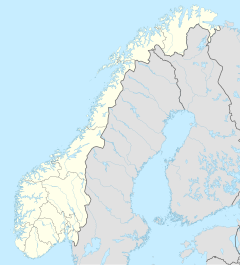Rago National Park
| Rago National Park | ||
|---|---|---|
|
|
||
| Location: | Nordland , Norway | |
| Surface: | 171 km² | |
| Founding: | 01/22/1971 | |
| The national parks in Northern Norway (The Rago is number 20) | ||
The Rago National Park ( Norwegian Rago nasjonalpark ) is a national park in Norway , which belongs to the municipality of Sørfold and is located in the province of Nordland . The name Rago comes from Sami and means "sledebreen" in Norwegian, literally translated as "sledge glacier". The park was founded in 1971 and has an area of 171 km², making it the sixth smallest national park in the country. It also borders the Swedish national parks Padjelanta , Sarek and Stora Sjöfallet . Together the four national parks have an area of around 5,400 km². Thus, they form one of the largest contiguous nature conservation areas in Europe.
Geography, landscape and geology
The park is a wild, glacial landscape with large forests, deep gorges, mountains and large boulders lying around freely. There are also three glaciers in the national park. The Ragotjahkka is 1,312 m.ö.h the highest mountain in the national park. The largest lakes are the Litlverivatnet and the Storskogvatnet . There are many smaller and larger waterfalls throughout the park area. The largest waterfall is the Værivassfossen (also called Litlverivassfossen), which falls 223 m deep from the Litlverivatnet into the Storskogdalen. Also known is the Trollfossen below the Storskogvatnet with a drop of over 100 meters (despite its name, it is not in Trolldalen). Despite the rather small size of the park, its number of waterfalls is unmatched by any other Norwegian national park.
The national park has a typical north Norwegian coastal climate with heavy rainfall, cold summers and mild winters. In the neighboring Swedish national parks, however, there is a continental climate with sometimes very cold winters.
The Storskogdalen runs from Lakshol in the west to Storskogvatnet in the northeast. The Storskogelva (also called Nordfjordelva) flows through pine forests and through the Storskogdalen through the park. The Trolldalen is a bit isolated in the north of Rago.
In the south, a long ridge dominates, with the Lappfjellet and Flatkjølen , which goes as far as Sweden.
flora
The flora shows a fairly manageable diversity and in some places there are also typical mountain plants, such as those found in B. occur in the Alps.
The soil is poor and the climate is inhospitable. In general, spruce and pine forests dominate, but above the tree line the dwarf birch is the most common tree. To the north of the Storskogvatnet there are also some pastures , rowanberry bushes , alpine milk lettuce and globeflowers .
Because the summer is not too warm, there are also high-alpine plants such as rose root and two-flowered violet . Swedish dogwood , black crowberries and herb willow also grow in the higher birch forests as well as in swamps and moors .
Due to the nutrient-rich slate soil , alpine rock flowers and common cat's paws also grow in the southeast .
fauna
The wildlife is not too diverse due to the park's northern location. The most common birds are snow bunting , meadow pipit, and ptarmigan . Song thrush , red thrush , fitis and garden warbler also live in the park . North of the Storskogsvatnet , besides numerous insects and mosquitoes, thrush , reed warbler , finches and tits live .
In Trolldalselva Delta there are dippers and Bluethroat . There are only a few plover-like birds there, but there are many other typical waterfowl such as golden-bellied duck , red-throated diver and common gull .
In the woods there are also typical forest birds such as black grouse and capercaillie .
There are only moose in large animals , but there are some wolverines and lynxes . Bears have been observed in the neighboring Swedish national parks, but not in the Rago since 1940. There are also foxes , minks and ermines among smaller predators . Arctic foxes and raccoons are rarely seen. There are also rabbits , squirrels and other small rodents in the park .
There is a great diversity of fish in the waters, especially in Storskogelva (Nordfjordelva) due to the many rapids. However, since there were large trout and arctic char farms in the river during and after the Second World War , there is still some overpopulation of these fish species.
heritage Site
In the past, the region was a popular hunting and reindeer herding area. The Sami , in particular , often wandered around here with their reindeer herds. During the First World War, silver and lead were also mined , albeit unprofitable .


